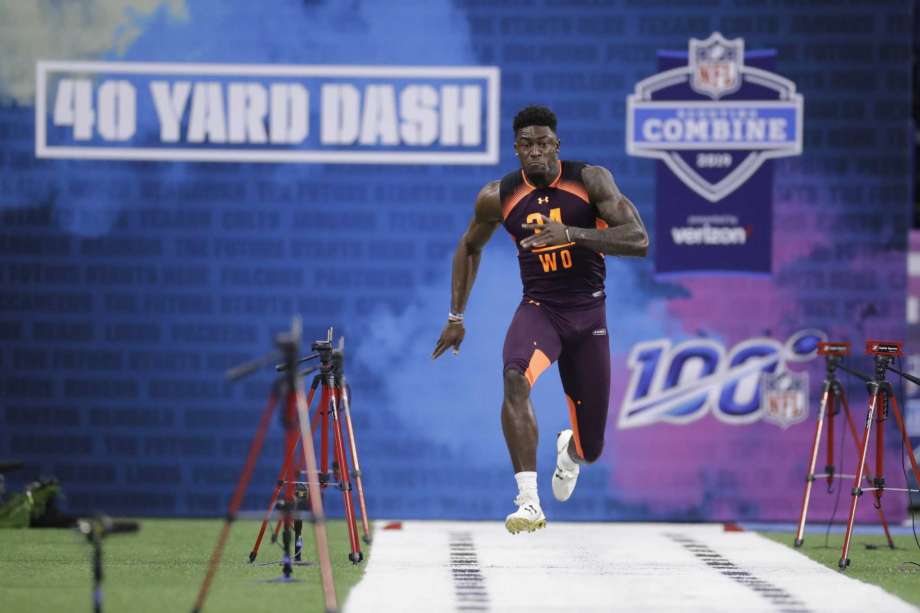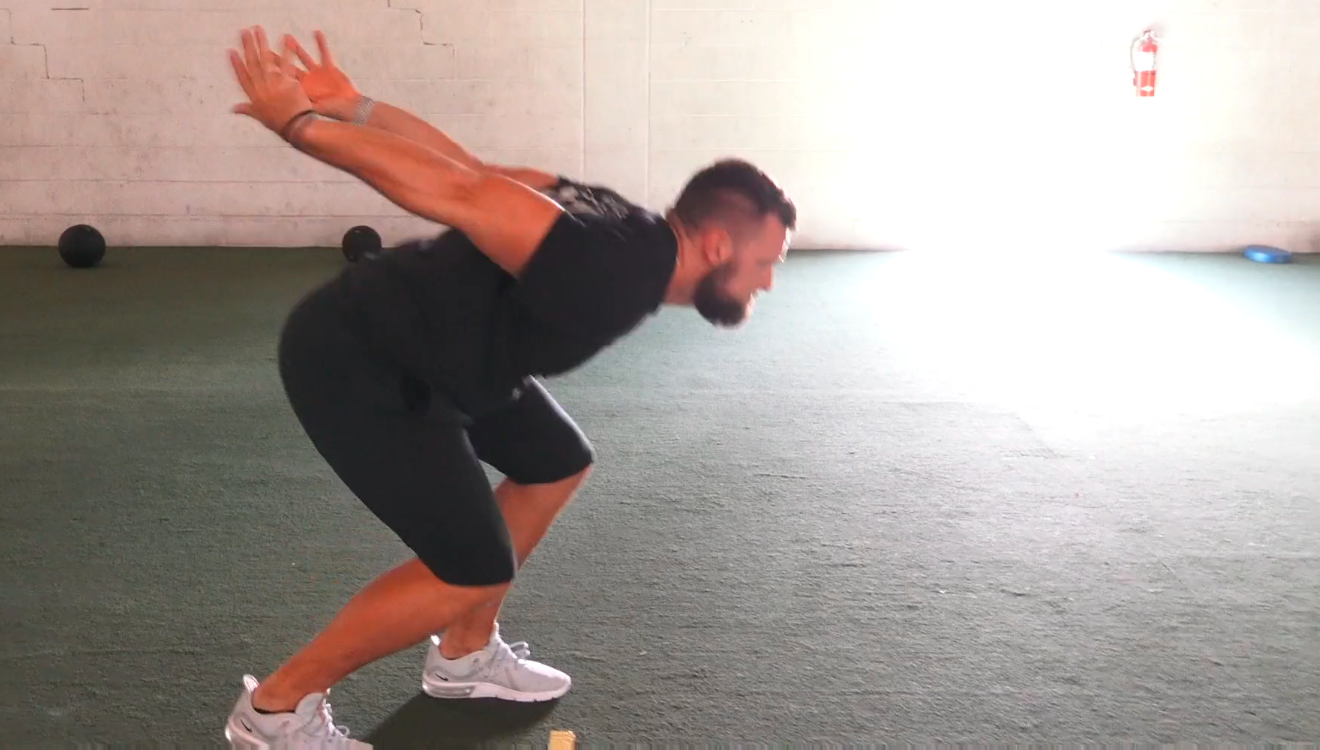FULL GUIDE to Your 40 Yard Dash (Including Mechanical Cues, Plyometrics, and Speed Drills)
If you play a skill position in football, your 40 time might be the most valuable skill event. Scouts and coaches all over the U.S. put a huge amount of weight into the 40 yard dash. And if you’re teetering between getting a college offer, or making the league, the 40 yard dash can be the event that pushes you over the edge.

Most athletes know this. And naturally, athletes ask me: What’s the quickest way to run a faster 40 yard dash?
The answer? Focus on the 40 yard dash start first.
The start of the 40 yard dash is the most critical part of the event. It sets the tone for the rest of your run. If you’re out of position, have the wrong shin angles, or have the wrong leg action, you won’t be able to apply as much force into the ground. In other words… You won’t run as fast.
Once you’ve honed your start, you can then place your focus on mechanical drills that raise your weaknesses and plyometrics to increase your power.
All of these components will work together to shave time off of your 40 yard dash.
Below, I’m going to share all of those components in depth to give you a complete guide to the 40 yard dash.
Whether you lack power, have trouble getting in the right 40 yard dash position, or have mechanical deficiencies, you’ll find your answers here.
Let’s get into it:
The 40 Yard Dash Start

As I said above, the start is the most critical piece of your 40 yard dash. If you mess this up, you’re screwed for the entire event.
You won’t generate enough force to reach high speeds, you’ll stumble out of your start. It won’t be pretty.
So, I’m about to go deep into the technical side of the start. This way, you can place your body in the right position, get a fast jump out of the gate, and see your 40 time drop.
The first area to address is the set up.
The 40 Yard Dash Set Up
- Establish your power leg. If you’re right handed, your power leg will usually be your left leg. If you’re left handed, your power leg is usually your right leg.
- Once you’ve established your power leg, place your power leg a half foot behind the line. Your non power leg (the opposite leg) should then be placed a foot behind the line.
- Next, you’ll make a 90 degree angle with your heels touching with your power leg facing straight ahead and the non power leg facing out to the side.
- Then, you’ll lift the heel of your non power leg and rotate it forward, You should have the heel of your power leg in line with the toes of your non power leg.
- Next, you’ll place your hand down. If your right leg is back, you’ll place your right hand down and vice versa.
- Once the hand is down, shift your weight forward so your shoulder is past your hand. This will create a more positive shin angle and facilitate better positioning.
- Finally, place your back arm by your back pocket and tuck your chin.
If you follow these steps, the stance you’ll find yourself in is the optimal one. You’ve created a positive shin angle and placed yourself in a position that will facilitate a horizontal explosion out of this position.
The 40 Yard Dash Take Off
- Before you’re about to take off, place 75% of your weight on your back leg, 25% on the front. This is a point of contention, but in my decade of coaching athletes, I’ve found that this weight distribution prevents iffy mechanics as it forces you to push off the back leg.
- When you push off, push off both legs. As you explode off, swing the back arm up explosively and throw the arm that was on the ground back.
- Keep your eyes down and chin tucked as you sprint
Common Errors in the 40 Yard Dash
I’m a coach known for my attention to detail when it comes to running. However, when an athletes runs a 40, I’ll rarely give mechanical cues that aren’t related to the start. In fact, there are only two mechanical cues I’ll give that aren’t related to the start.
The first has to do with the arms. The arms should stay tight and the hands should move from cheek to cheek. Not out to the side, or flailing around.
The next has to do with the hips. Many athletes have a tendency to push off one leg in the 40 yard start. I want the athlete to push off both legs and reach full hip extension before he takes his first stride.
3 Acceleration Drills for a Faster 40 Yard Dash
There are many common mechanical deficiencies among athletes who want to run a faster 40 yard dash. These deficiencies get in the way of the athlete reaching his speed potential.
Below, I’m going to share a few acceleration drills that will help you correct these deficiencies and run a faster 40 yard dash.
1. Half Kneeling Starts
Half kneeling starts are one of my favorite acceleration for any athlete across the board. For one, they work the explosiveness of the front leg through a deeper range of motion. This will ultimately carryover to more explosiveness when the athlete comes out of a two point start, 40 start, or some other sport specific start.
Second, the position the athlete is in during the half kneeling start encourages good acceleration mechanics.
This is a MUST HAVE acceleration drill for any athlete.
How to Perform Half Kneeling Starts:
- Start in a half kneeling position with your power leg in front.
- Drive that knee over the toe
- Explode out of this position horizontally and move down the field
2. Kick Up Starts
Kick up starts are for the athlete who have the urge to “pop up” out of their 40 stance. This drill encourages the athlete to keep a forward lean and positive shin angle because the athlete is exploding out of a low position.
Kick up starts also allow the athlete to react off the ground and generate more force than he normally would out of a static position. I call this “raising the threshold”.
How to Perform Kick Up Starts:
- Start in a 4 point stance with your power leg slightly in front of your other leg
- Kick off the ground using both legs
- As your feet make contact with the ground again, react off the ground and explode out horizontally
3. Sled Pulls
Finally, we arrive at a resisted acceleration drills. Sled pulls add some resistance to the athlete’s acceleration training, which will carry over to more speed when accelerating as long as the resistance doesn’t create mechanical flaws.
The weight also allows the athlete to lean forward into his acceleration position, making the athlete more accustom to being in the proper positions.
How to Perform Sled Pulls:
- Start with your arms by your sides, palms facing away from you holding the sled rope in your hands
- Lean forward like you would when you sprint
- Flex your hip until you see the knee over your toe then push off the ground and repeat for desired distance
3 Plyometrics for a Faster 40 Yard Dash
Technical starts and mechanical drills alone don’t always result in a faster 40 time. Sometimes you need more pop in your step. That’s where plyometrics come in. Not only will these plyometrics put more pop in your step, but some will actually help you with your start.
1. Staggered Stance Broad Jumps
Remember above when I spoke about the importance of extending both hips before the first stride of your 40? Well, this plyometric will help you with that.
The staggered stance broad jump forces the athlete to perform an explosive jump with their feet set in a 40 stance position. Again, this will teach the athlete to extend both hips before taking his first stride as that’s what he needs to do to succeed with his staggered stance broad jumps.

How to Perform Staggered Stance Broad Jumps:
- Begin with your feet in 40 yard dash position
- Push the hips back and lean the torso forward
- Explode out as far as you can and land softly
2. Single Leg Triple Jump
Single leg triple jumps are another one of my go to plyometrics to help athletes run a faster 40 yard dash. This drill teaches the athlete to be explosive on one leg. They also work the athlete’s amortization phase, or ground contact time.
This will help the athlete produce high amounts of force with short ground contact times, which will carry over to a faster 40 yard dash.
How to Perform Single Leg Triple Jumps:
- Stand on one leg
- Load the hips up and bend the knee slightly
- Explode out with a sub-maximal broad jump
- Make contact with the ground and push into another jump
- Repeat the last step one more time and land on two feet
3. Single Leg Cycling
Single leg cycling is a quasi plyometric-mechanical drill hybrid. This drill will build explosive capacity on a single leg. It will also teach the athlete proper leg action, or the mechanics of the leg as he runs.
Many athletes perform inefficient swooping motions during the steps of their 40 yard dash. This drill will help correct that.
How to Perform Single Leg Cycling:
- Create momentum and push off one leg
- When you push off that leg, pop the knee up with your leg in triple flexion
- Bring that leg towards the ground and repeat this process
- Repeat for the desired distance
More Support for Your 40 Yard Dash

These acceleration mechanics drills and plyometrics are by no means the end all to a faster 40 yard dash.
In fact, if you really want to impress scouts, coaches, and even entire organizations with your speed, you MUST have a dedicated approach to getting faster.
That approach should include:
- Mechanical Drills
- Plyometrics
- Elastic Strength Training
- Core Stability
And more to give you speed that gets you playing time… Or better… PAID.
You can find that approach in Athletic Speed System.
Thousands of athletes have poured into the Athletic Speed System and reaped incredible results.
You could be next.
But, before you make an emotional decision, find out what’s inside by clicking the link below:
